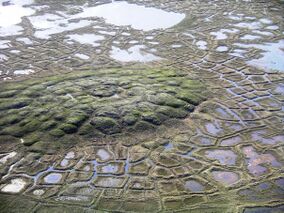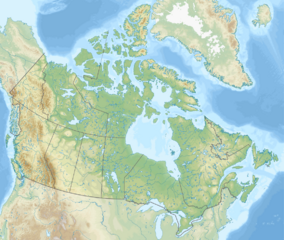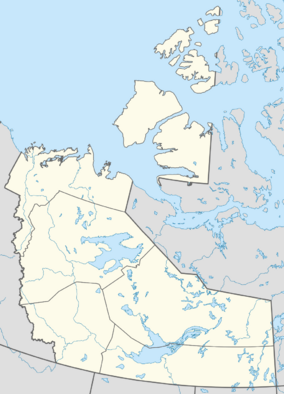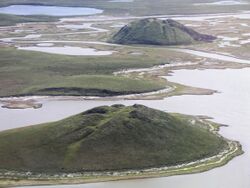Earth:Pingo National Landmark
| Pingo National Landmark | |
|---|---|
 A melting pingo with wedge ice in Pingo National Landmark | |
| Location | Northwest Territories, Canada |
| Nearest city | Tuktoyaktuk, Inuvik, NT |
| Coordinates | [ ⚑ ] : 69°23′59″N 133°04′47″W / 69.39972°N 133.07972°W |
| Area | 16 km2 (6.2 sq mi) |
| Established | 1984 |
| Governing body | Parks Canada |
| www | |
Pingo National Landmark is a natural area protecting eight pingos near Tuktoyaktuk, Northwest Territories. It is in a coastal region of the Arctic Ocean which contains approximately 1,350 Arctic ice dome hills—approximately one quarter of the world's pingos.[1]
The Landmark comprises an area roughly 16 km2 (6.2 sq mi), just 5 km (3.1 mi) west of Tuktoyaktuk, and includes Ibyuk Pingo—Canada 's highest, exceeded in height only by Kadleroshilik Pingo in Alaska—at 49 m (161 ft).[1] The Landmark, which lies within the Inuvialuit Settlement Region, is managed by Parks Canada under the National Parks Act. Although a nationwide landmarks program was envisioned at its creation, Pingo remains the country's only National Landmark.[2]
In a region near the Beaufort Sea which is quite flat, pingos dominate the skyline, rising from 5 to 36 m (16 to 118 ft), in various stages of growth and collapse. Ibyuk Pingo, the highest, continues to grow about 2 cm (0.79 in) per year, and is estimated to be at least 1,000 years old. Unique to areas of permafrost, pingos have formed here thanks to numerous lakes in the Tuktoyaktuk Peninsula.
Fauna
Animals that inhabit this park include grizzly and polar bears, wolf packs, two species of fox, and Arctic ground squirrels. Birds that either nest or migrate around the park are brant geese, tundra swans, lesser snow geese, loons, and greater white-fronted geese. Ducks such as mallard, green-winged teal, king eider, common eider, and oldsquaw are common to this area as well as a variety of gulls and shorebird species.
Other features
Besides pingos, the Landmark contains an excellent example of massive ice. One section of the frozen groundwater, part of an eroded hillside by the sea, is over 500 m (1,600 ft) long, and 10 m (33 ft) high. Other less visible ice beds in the region are over 40 m (130 ft) thick. This type of ice is found in permafrost, and can be thousands of years old.
Other features of a permafrost environment can be found in the Landmark, including wedge ice. These are vertical masses of ice that form after water freezes in the cracks around ground that has contracted due to extreme cold. When ice wedges connect to one another, they can form tundra polygons, which are also visible at Pingo National Landmark.
Landmark recognition
The area has been a focus of scientific study for over 50 years, and research here has formed the basis of current understanding about the origin and growth of pingos. The region was first identified as a site of national significance in 1978, and landmark status was proposed. Legislation creating it in 1984 formed part of the Inuvialuit Final Agreement (officially, the Western Arctic (Inuvialuit) Claims Settlement Act (1984)).[3] It provided for cooperative management of the Landmark between the Government of Canada, the Inuvialuit Land Administration, and the people of Tuktoyaktuk. It reserved subsurface rights for the Inuvialuit, federal jurisdiction for the surface, and that the pingos would be preserved unimpaired.
Visiting the Landmark
In August 2010 a boardwalk trail was completed with a boat launch, dock and viewing platforms; interpretive signage is planned by Parks Canada for self-guided tours. Local tour operators provide guided access to the site, which is easiest by boat. Hiking provides a more challenging option, but no matter how visitors access the site, Arctic weather and varying water levels can force a change of plans and an alternate route of return.
The landmark was featured in Billy Connolly: Journey to the Edge of the World, a 2008 transcontinental land, sea, and air journey by the Scottish entertainer.[4]
References
- ↑ 1.0 1.1 Parks Canada (2005). "Pingo National Landmark". Archived from the original on 2007-06-03. https://web.archive.org/web/20070603210903/http://www.pc.gc.ca/docs/v-g/pingo/index_e.asp. Retrieved 2008-01-05.
- ↑ Parks Canada (2005). "Pingo National Landmark". Archived from the original on 2011-06-05. https://web.archive.org/web/20110605075427/http://www.pc.gc.ca/eng/docs/v-g/pingo/sec6.aspx. Retrieved 2013-10-16.
- ↑ Inuvialuit Final Agreement
- ↑ Billy Connolly: Journey to the Edge of the World, episode 3 (at approx. the 27:30 minute mark).




